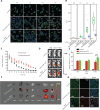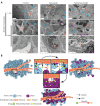Boosting of the enhanced permeability and retention effect with nanocapsules improves the therapeutic effects of cetuximab
- PMID: 32587779
- PMCID: PMC7309461
- DOI: 10.20892/j.issn.2095-3941.2019.0292
Boosting of the enhanced permeability and retention effect with nanocapsules improves the therapeutic effects of cetuximab
Abstract
Objective: The introduction of therapeutic antibodies (tAbs) into clinical practice has revolutionized tumor treatment strategies, but their tumor therapy efficiency is still far below expectations because of the rapid degradation and limited tumor accumulation of tAbs. Methods: We developed a nanocapsule-based delivery system to induce the self-augmentation of the enhanced permeability and retention (EPR) effect. This system constantly penetrated across the blood-tumor barrier into the tumor while avoiding the attack of tAbs by the immune system. The biodistribution and therapeutic effect were tested with single dose administration of nanocapsule-tAbs in vivo. Results: The accumulation of Nano(cetuximab) within subcutaneous PC9 tumors was gradually enhanced over 6 days after single dose administration, which was contrary to the biodistribution of native cetuximab. Nano(cetuximab) accumulated in tumor tissues via the EPR effect and released cetuximab. The released cetuximab acted on vascular endothelial cells to destroy the blood-tumor barrier and induce self-augmentation of the EPR effect, which in turn contributed to further tumor accumulation of long-circulating Nano(cetuximab). Compared with single dose administration of native cetuximab, Nano(cetuximab) showed an effective tumor suppressive effect for 3 weeks. Conclusions: The nanocapsule-based delivery system efficiently delivered tAbs to tumor tissues and released them to boost the EPR effect, which facilitated further tumor accumulation of the tAbs. This novel self-augmentation of the EPR effect facilitated by the biological characteristics of tAbs and nanotechnology contributed to the improvement of the therapeutic effect of tAbs, and stimulated new ideas for antibody-based tumor therapy.
Keywords: EPR effect; Endothelial cells; nanocapsule; single dose administration; therapeutic antibody.
Copyright: © 2020, Cancer Biology & Medicine.
Conflict of interest statement
*These authors contributed equally to this work.
Figures





Similar articles
-
Glioma-derived exosomes hijack the blood-brain barrier to facilitate nanocapsule delivery via LCN2.J Control Release. 2022 May;345:537-548. doi: 10.1016/j.jconrel.2022.03.038. Epub 2022 Mar 25. J Control Release. 2022. PMID: 35341902
-
Time-dependent pretreatment with bevacuzimab increases tumor specific uptake of cetuximab in preclinical oral cavity cancer studies.Cancer Biol Ther. 2015;16(5):790-8. doi: 10.1080/15384047.2015.1016664. Epub 2015 Feb 26. Cancer Biol Ther. 2015. PMID: 25719497 Free PMC article.
-
A nanocapsular combinatorial sequential drug delivery system for antiangiogenesis and anticancer activities.Biomaterials. 2010 Sep;31(27):7115-23. doi: 10.1016/j.biomaterials.2010.05.075. Epub 2010 Jun 23. Biomaterials. 2010. PMID: 20576288
-
Development of next-generation macromolecular drugs based on the EPR effect: challenges and pitfalls.Expert Opin Drug Deliv. 2015 Jan;12(1):53-64. doi: 10.1517/17425247.2014.955011. Epub 2014 Nov 26. Expert Opin Drug Deliv. 2015. PMID: 25425260 Review.
-
Exploiting the dynamics of the EPR effect and strategies to improve the therapeutic effects of nanomedicines by using EPR effect enhancers.Adv Drug Deliv Rev. 2020;157:142-160. doi: 10.1016/j.addr.2020.06.005. Epub 2020 Jun 14. Adv Drug Deliv Rev. 2020. PMID: 32553783 Review.
Cited by
-
Examining the Impact of Sonodynamic Therapy With Ultrasound Wave in the Presence of Curcumin-Coated Silver Nanoparticles on the Apoptosis of MCF7 Breast Cancer Cells.IET Nanobiotechnol. 2025 Jul 15;2025:7036856. doi: 10.1049/nbt2/7036856. eCollection 2025. IET Nanobiotechnol. 2025. PMID: 40698351 Free PMC article.
-
Phase-Transformation Nanoparticle-Mediated Sonodynamic Therapy: An Effective Modality to Enhance Anti-Tumor Immune Response by Inducing Immunogenic Cell Death in Breast Cancer.Int J Nanomedicine. 2021 Mar 5;16:1913-1926. doi: 10.2147/IJN.S297933. eCollection 2021. Int J Nanomedicine. 2021. PMID: 33707946 Free PMC article.
-
Efficient delivery of anlotinib and radioiodine by long circulating nano-capsules for active enhanced suppression of anaplastic thyroid carcinoma.J Nanobiotechnology. 2025 Mar 6;23(1):180. doi: 10.1186/s12951-025-03223-2. J Nanobiotechnology. 2025. PMID: 40050959 Free PMC article.
-
Evaluation of the liver targeting and anti‑liver cancer activity of artesunate‑loaded and glycyrrhetinic acid‑coated nanoparticles.Exp Ther Med. 2023 Sep 21;26(5):516. doi: 10.3892/etm.2023.12215. eCollection 2023 Nov. Exp Ther Med. 2023. PMID: 37854499 Free PMC article.
References
-
- Meulendijks D, Jacob W, Voest EE, Mau-Sorensen M, Martinez-Garcia M, Taus A, et al. Phase Ib study of lumretuzumab plus cetuximab or erlotinib in solid tumor patients and evaluation of HER3 and heregulin as potential biomarkers of clinical activity. Clin Cancer Res. 2017;23:5406–15. - PubMed
-
- Hewish M, Cunningham D. First-line treatment of advanced colorectal cancer. Lancet. 2011;377:2060–2. - PubMed
-
- Ciardiello F, Tortora G. EGFR antagonists in cancer treatment. N Engl J Med. 2008;358:1160–74. - PubMed
Publication types
MeSH terms
Substances
LinkOut - more resources
Full Text Sources
